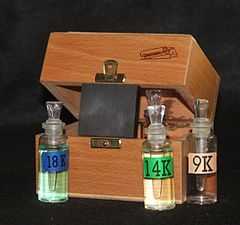Touchstone (assaying tool)

A touchstone is a small tablet of dark stone such as fieldstone, slate, or lydite, used for assaying precious metal alloys. It has a finely grained surface on which soft metals leave a visible trace.[1]
History
The touchstone was used in ancient Greece. Its role in the introduction of monetary economy was explored by science historian James Burke in the second episode of his 1978 BBC television series Connections.
It was also used by Indus Valley Civilization about 3500 BC for testing the purity of soft metals.[2]
Usage
Drawing a line with gold on a touchstone will leave a visible trace. Because different alloys of gold have different colours (see gold) the unknown sample can be compared to samples of known purity. This method has been used since ancient times. In modern times, additional tests can be done. The trace will react differently to specific concentrations of nitric acid or aqua regia, thereby identifying the quality of the gold. Thus, 24 carat gold is not affected but 14 carat gold will show chemical activity.
See also
- Touchstone (metaphor) — for metaphorical and literary uses of the term
- Litmus — a test for pH levels
References
- ↑ "Touchstone". Oxford English Dictionary. Retrieved 10 March 2013.
- ↑ Bisht, R. S. (1982). "Excavations at Banawali: 1974-77". In Possehl, Gregory L. Harappan Civilization: A Contemporary Perspective. New Delhi: Oxford and IBH Publishing Co. pp. 113–124.
External links
- This article incorporates information from this version of the equivalent article on the Japanese Wikipedia.